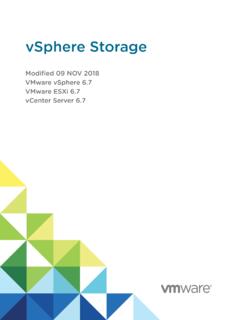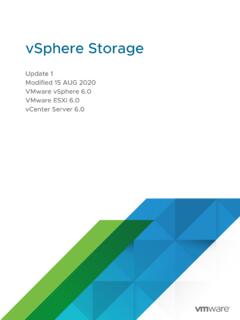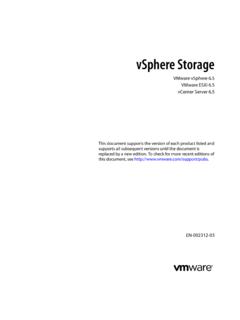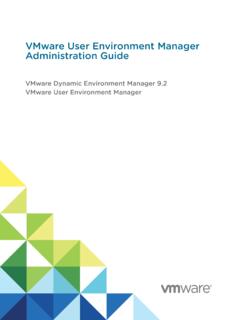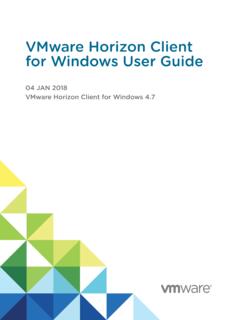Transcription of vSphere Storage - VMware vSphere 6
1 vSphere StorageUpdate 1 Modified 20 MAR 2018 VMware vSphere ESXi Server StorageVMware, Inc. 2 You can find the most up-to-date technical documentation on the VMware website at: you have comments about this documentation, submit your feedback 2009 2018 VMware , Inc. All rights reserved. Copyright and trademark , Hillview Alto, CA vSphere Storage 8 Updated Information 9 1 Introduction to Storage 10 Traditional Storage Virtualization Models 10 Software-Defined Storage Models 12vSphere Storage APIs 12 2 Getting Started with a Traditional Storage Model 14 Types of Physical Storage 14 Supported Storage Adapters 25 Datastore Characteristics 26 3 Overview of Using ESXi with a SAN 30 ESXi and SAN Use Cases 31 Specifics of Using SAN Storage with ESXi 31 ESXi Hosts and Multiple Storage Arrays 32 Making LUN Decisions 32 Selecting Virtual Machine Locations 34 Third-Party Management Applications 34 SAN Storage Backup Considerations 35 4 Using ESXi with Fibre Channel SAN 37 Fibre Channel SAN Concepts 37 Using Zoning with Fibre Channel SANs 39 How Virtual Machines Access Data on a Fibre Channel SAN 39 5 Configuring Fibre Channel Storage 41 ESXi Fibre Channel SAN Requirements 41 Installation and Setup Steps 43N-Port ID Virtualization 43 6 Configuring Fibre Channel over Ethernet
2 47 Fibre Channel over Ethernet Adapters 47 Configuration Guidelines for Software FCoE 48 Set Up Networking for Software FCoE 48 Add Software FCoE Adapters 49 VMware , Inc. 3 7 Booting ESXi from Fibre Channel SAN 51 Boot from SAN Benefits 51 Requirements and Considerations when Booting from Fibre Channel SAN 52 Getting Ready for Boot from SAN 52 Configure Emulex HBA to Boot from SAN 54 Configure QLogic HBA to Boot from SAN 55 8 Booting ESXi with Software FCoE 57 Requirements and Considerations for Software FCoE Boot 57 Best Practices for Software FCoE Boot 58 Set Up Software FCoE Boot 58 Troubleshooting Boot from Software FCoE for an ESXi Host 60 9 Best Practices for Fibre Channel Storage 61 Preventing Fibre Channel SAN Problems 61 Disable Automatic Host Registration 62 Optimizing Fibre Channel SAN Storage Performance 62 10 Using ESXi with iSCSI SAN 65iSCSI SAN Concepts 65 How Virtual Machines Access Data on an iSCSI SAN 71 11 Configuring iSCSI Adapters and Storage 72 ESXi iSCSI SAN Requirements 73 ESXi iSCSI SAN Restrictions 73 Setting LUN Allocations for iSCSI 73 Network Configuration and Authentication 74 Set
3 Up Independent Hardware iSCSI Adapters 74 About Dependent Hardware iSCSI Adapters 78 About the Software iSCSI Adapter 82 Modify General Properties for iSCSI Adapters 86 Setting Up iSCSI Network 87 Using Jumbo Frames with iSCSI 98 Configuring Discovery Addresses for iSCSI Adapters 100 Configuring CHAP Parameters for iSCSI Adapters 101 Configuring Advanced Parameters for iSCSI 106iSCSI Session Management 108 12 Booting from iSCSI SAN 111 General Recommendations for Boot from iSCSI SAN 111 Prepare the iSCSI SAN 112vSphere StorageVMware, Inc. 4 Configure Independent Hardware iSCSI Adapter for SAN Boot 113iBFT iSCSI Boot Overview 114 13 Best Practices for iSCSI Storage 120 Preventing iSCSI SAN Problems 120 Optimizing iSCSI SAN Storage Performance 121 Checking Ethernet Switch Statistics 125 14 Managing Storage devices 126 Storage Device Characteristics 126 Understanding Storage Device Naming 129 Storage Rescan Operations 131 Identifying Device Connectivity Problems 133 Edit Configuration File Parameters 139 Enable or Disable the Locator LED on Storage devices 139 Erase Storage devices 140 15 Working with Flash devices 141 Using Flash devices with ESXi 141 Marking Storage devices 142 Monitor Flash devices 144 Best Practices for Flash devices 144 About Virtual Flash Resource 145 Configuring Host Swap Cache 148 16 About VMware vSphere Flash Read Cache 150 DRS Support for Flash Read Cache 151vSphere High Availability Support for Flash Read Cache 151 Configure Flash Read Cache for a
4 Virtual Machine 151 Migrate Virtual Machines with Flash Read Cache 152 17 Working with Datastores 154 Types of Datastores 154 Understanding VMFS Datastores 155 Understanding Network File System Datastores 165 Creating Datastores 177 Managing Duplicate VMFS Datastores 180 Increasing VMFS Datastore Capacity 182 Administrative Operations for Datastores 184 Set Up Dynamic Disk Mirroring 192 Collecting Diagnostic Information for ESXi Hosts on a Storage Device 193 Checking Metadata Consistency with VOMA 197vSphere StorageVMware, Inc. 5 Configuring VMFS Pointer Block Cache 199 18 Understanding Multipathing and Failover 201 Failovers with Fibre Channel 201 Host-Based Failover with iSCSI 202 Array-Based Failover with iSCSI 204 Path Failover and Virtual Machines 205 Managing Multiple Paths 206 VMware Multipathing Module 207 Path Scanning and Claiming 209 Managing Storage Paths and Multipathing Plug-Ins 213 Scheduling Queues for Virtual Machine I/Os 224 19 Raw Device Mapping 226 About Raw Device Mapping 226 Raw Device Mapping Characteristics 230 Create Virtual Machines with RDMs 232 Manage Paths for a Mapped LUN 233 20 Software-Defined Storage and Storage Policy Based Management 234 About Storage Policy Based Management 234 Virtual Machine Storage Policies 235 Working with Virtual Machine Storage Policies 236 Populating the VM Storage Policies Interface 236 Default Storage Policies 240 Creating and Managing VM Storage Policies 242 Storage Policies and Virtual Machines 253 21
5 Using Storage Providers 260 About Storage Providers 260 Storage Providers and Data Representation 261 Storage Provider Requirements and Considerations 262 Register Storage Providers 262 View Storage Provider Information 263 Unregister Storage Providers 264 Update Storage Providers 264 Refresh Storage Provider Certificates 265 22 Working with Virtual Volumes 266 About Virtual Volumes 266 Virtual Volumes Concepts 267 Virtual Volumes and Storage Protocols 272vSphere StorageVMware, Inc. 6 Virtual Volumes Architecture 273 Virtual Volumes and VMware Certificate Authority 275 Snapshots and Virtual Volumes 276 Before You Enable Virtual Volumes 276 Configure Virtual Volumes 278 Provision Virtual Machines on Virtual Volumes Datastores 281 Virtual Volumes and Replication 285 Best Practices for Working with vSphere Virtual Volumes 290 23 Filtering Virtual Machine I/O 295 About I/O Filters 295 Using Flash Storage devices with Cache I/O Filters 298 System Requirements for I/O Filters 299 Configure I/O Filters in the vSphere Environment 300 Managing I/O Filters 305I/O Filter Guidelines and Best Practices 307 24 Storage Hardware Acceleration 309 Hardware Acceleration Benefits 309 Hardware Acceleration Requirements 310 Hardware Acceleration Support Status 310 Hardware Acceleration for Block Storage devices 310 Hardware Acceleration on NAS devices 316 Hardware Acceleration Considerations 319 25 Thin Provisioning and Space Reclamation 321
6 Virtual Disk Thin Provisioning 321 ESXi and Array Thin Provisioning 326 Storage Space Reclamation 328 26 Using vmkfstools 335vmkfstools Command Syntax 335 The vmkfstools Command Options 336vSphere StorageVMware, Inc. 7 About vSphere StoragevSphere Storage describes virtualized and software-defined Storage technologies that VMware ESXi and VMware vCenter Server offer, and explains how to configure and use these AudienceThis information is for experienced system administrators who are familiar with the virtual machine andstorage virtualization technologies, data center operations, and SAN Storage Web Client and vSphere ClientTask instructions in this guide are based on the vSphere Web Client. You can also perform most of thetasks in this guide by using the new vSphere Client. The new vSphere Client user interface terminology,topology, and workflow are closely aligned with the same aspects and elements of thevSphere Web Client user interface. You can apply the vSphere Web Client instructions to the newvSphere Client unless otherwise Not all functionality in the vSphere Web Client has been implemented for the vSphere Client in thevSphere release.
7 For an up-to-date list of unsupported functionality, see Functionality Updates for thevSphere Client Guide at , Inc. 8 Updated InformationThis vSphere Storage is updated with each release of the product or when table provides the update history of the vSphere MAR 2018 Minor JAN 2018 Minor OCT 2017 Minor , Inc. 9 Introduction to Storage1vSphere supports various Storage options and functionalities in traditional and software-defined storageenvironments. A high-level overview of vSphere Storage elements and aspects helps you plan a properstorage strategy for your virtual data chapter includes the following topics:nTraditional Storage Virtualization ModelsnSoftware-Defined Storage ModelsnvSphere Storage APIsTraditional Storage Virtualization ModelsGenerally, Storage virtualization refers to a logical abstraction of physical Storage resources andcapacities from virtual machines and their applications. ESXi provides host-level Storage vSphere environment, a traditional model is built around the following Storage technologies and ESXiand vCenter Server virtualization and NetworkedStorageIn traditional Storage environments, the ESXi Storage management processstarts with Storage space that your Storage administrator preallocates ondifferent Storage systems.
8 ESXi supports local Storage and Types of Physical Area NetworksA Storage area network (SAN) is a specialized high-speed network thatconnects computer systems, or ESXi hosts, to high-performance storagesystems. ESXi can use Fibre Channel or iSCSI protocols to connect tostorage chapter 3 Overview of Using ESXi with a ChannelFibre Channel (FC) is a Storage protocol that the SAN uses to transfer datatraffic from ESXi host servers to shared Storage . The protocol packagesSCSI commands into FC frames. To connect to the FC SAN, your hostuses Fibre Channel host bus adapters (HBAs).See chapter 4 Using ESXi with Fibre Channel , Inc. 10 Internet SCSII nternet iSCSI (iSCSI) is a SAN transport that can use Ethernetconnections between computer systems, or ESXi hosts, and high-performance Storage systems. To connect to the Storage systems, yourhosts use hardware iSCSI adapters or software iSCSI initiators withstandard network chapter 10 Using ESXi with iSCSI Device or LUNIn the ESXi context, the terms device and LUN are used , both terms mean a Storage volume that is presented to the hostfrom a block Storage system and is available for Target and Device Representations and chapter 14 Managing DisksA virtual machine on an ESXi host uses a virtual disk to store its operatingsystem, application files, and other data associated with its activities.
9 Virtualdisks are large physical files, or sets of files, that can be copied, moved,archived, and backed up as any other files. You can configure virtualmachines with multiple virtual access virtual disks, a virtual machine uses virtual SCSI virtual controllers include BusLogic Parallel, LSI Logic Parallel, LSIL ogic SAS, and VMware Paravirtual. These controllers are the only types ofSCSI controllers that a virtual machine can see and virtual disk resides on a datastore that is deployed on physicalstorage. From the standpoint of the virtual machine, each virtual diskappears as if it were a SCSI drive connected to a SCSI controller. Whetherthe physical Storage is accessed through Storage or network adapters onthe host is typically transparent to the VM guest operating system vSphere VMFSThe datastores that you deploy on block Storage devices use the nativevSphere Virtual Machine File System (VMFS) format. It is a special high-performance file system format that is optimized for storing Understanding VMFS NFS client built into ESXi uses the Network File System (NFS) protocolover TCP/IP to access an NFS volume that is located on a NAS server.
10 TheESXi host can mount the volume and use it as an NFS Understanding Network File System Device MappingIn addition to virtual disks, vSphere offers a mechanism called raw devicemapping (RDM). RDM is useful when a guest operating system inside avirtual machine requires direct access to a Storage device. For informationabout RDMs, see chapter 19 Raw Device StorageVMware, Inc. 11 Software-Defined Storage ModelsIn addition to abstracting underlying Storage capacities from VMs, as traditional Storage models do,software-defined Storage abstracts Storage the software-defined Storage model, a virtual machine becomes a unit of Storage provisioning andcan be managed through a flexible policy-based mechanism. The model involves the following Policy BasedManagementStorage Policy Based Management (SPBM) is a framework that provides asingle control panel across various data services and Storage solutions,including vSAN and Virtual Volumes. Using Storage policies, the frameworkaligns application demands of your virtual machines with capabilitiesprovided by Storage chapter 20 Software-Defined Storage and Storage Policy vSphere Virtual Volumes The Virtual Volumes functionality changes the Storage managementparadigm from managing space inside datastores to managing abstractstorage objects handled by Storage arrays.
